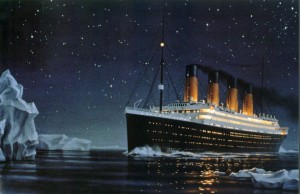Titanic: 100 Years Later
 On April 10th, 1912 Titanic set sail on her maiden voyage from Southampton, England to New York City. The “floating palace” was supposed to reach NY within seven days, but it never reached the destination that held hopes and dreams to the passengers.
On April 10th, 1912 Titanic set sail on her maiden voyage from Southampton, England to New York City. The “floating palace” was supposed to reach NY within seven days, but it never reached the destination that held hopes and dreams to the passengers.
The gigantic ship started being built March 31st, 1909 in Belfast, Ireland. Titanic was the second of three Olympic-class ocean liners-the others were the RMS Olympic and the HMHS Britannic. This ships were constructed by Belfast shipbuilding company Harland and Wolff Heavy Industries. The ship was completed on April 2nd, 1911 and began its journey to North America just eight days later. At the time, it was the largest movable man-made object in the world.
Her passengers included some of the wealthiest in the world, as well as over a thousand immigrants from Great Britain, Ireland, and Scandinavia. All of them had one goal in mind, which was to start a new life in America. Titanic’s passengers were divided into three seperate classes: First class (businessmen, politicians, high-ranking military personnel, industrialists, bankers and professional athletes), Second class (professors, authors, clergymen and tourists), and Third class (primarily immigrants). According to History.com passengers traveling first class on Titanic were roughly 44 percent more likely to survive than other passengers.
Some hypotheses suggest that the Titanic was doomed from the start. Due to some of the design choices such as the watertight bulkheads. While the individual bulkheads were indeed watertight, water could spill from one compartment into another. Also, the number of lifeboats could not hold the number of people that were aboard. Which means, there were only avaliable seats on a lifeboat to one third of the passengers.
On April 14th, 1912, four days into the crossing and 375 miles south of Newfoundland, she hit an iceberg at 11:40 p.m. The collison caused Titanic’s hull plates to buckle inwards in a number of locations on her starboard side and opened five of her sixteen watertight compartments to the sea. It only took two and a half hours for the ship to fill with water and sink. The sinking of the Titanic caused the deaths of 1,514 people. The 710 survivors were taken aboard from the lifeboats by the RMS Carpathia a few hours later.
It has been 100 years since the Titanic sank to the bottom of the North Atlantic Ocean. We must remember the lives that were lost in this horrible accident that is considered one of the deadliest peacetime maritime disasters in history.


